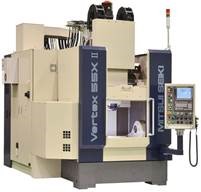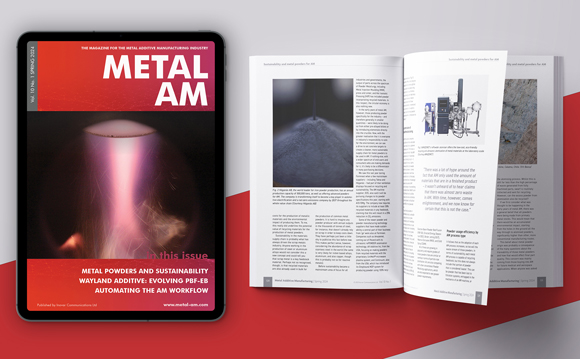Mitsui Seiki launches hybrid additive and vertical machining centre system
August 31, 2016

The new hybrid system is based on Mitsui Seiki’s Vertex 55X platform
Mitsui Seiki USA, Inc., Franklin Lakes, New Jersey, a wholly owned subsidiary of Japan’s Mitsui Seiki Kogyo Co., Ltd, has developed new machining technology that successfully combines both an additive and subtractive process on one machine tool platform. The Vertex 55X-H combines a traditional CNC vertical machining centre with a spindle-adapted laser DED (Direct Energy Deposition) / powder feed nozzle.
Mitsui states that parts can be 3D printed from scratch or material can be added to existing parts. The nozzle loads into the tool changer as with any conventional tool and is changed automatically via the CNC program prompts. A milling/drilling tool replaces it and aspects of the workpiece can be machined conventionally.
“The process is under full adaptive control as we are making the part, ensuring that as we’re moving back and forth between additive and subtractive, we are maintaining the intended surface or feature as it’s being produced,” stated Robb Hudson, Technology & Business Development Manager. “In addition to developing the integrated spindle-adapted fibre laser and powder-feed system, this is the main benefit that Mitsui Seiki offers as compared to other hybrid systems on the market: our machine maintains common centre line integrity between nozzle and tool as users go back and forth between the additive nozzle and the subtractive tool and offers a sub-15 micron volumetric accuracy within the work envelope.”
The applications ideally suited to Mitsui Seiki’s particular hybrid machining solution include the repair of a number of different types of aerofoil parts, such as high-pressure turbine and compressor blades, low pressure blades, blisks/IBRs and impellers for the aerospace, power generation, and oil and gas industries. Further, as large truck and off-road equipment OEMs use more super hard materials in the production of parts and diesel engines, hybrid technology is ideal for repair operations in those industries as well. General part recovery is another area where hybrid machinery could be used to great advantage in traditional machining environments where a scrapped part can cost a company up to hundreds of thousands of dollars.
“Over time we will likely see hundreds of additional application opportunities in multiple industries. In the very near future we will be able to add nozzles for localized heat treatment, cleaning the workpiece surface, drying the part of coolant residue, and even laser drilling and cutting. The possibilities are virtually endless,” added Hudson.
















